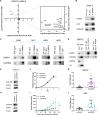PARP4 interacts with hnRNPM to regulate splicing during lung cancer progression
- PMID: 39034402
- PMCID: PMC11265163
- DOI: 10.1186/s13073-024-01328-1
PARP4 interacts with hnRNPM to regulate splicing during lung cancer progression
Abstract
Background: The identification of cancer driver genes from sequencing data has been crucial in deepening our understanding of tumor biology and expanding targeted therapy options. However, apart from the most commonly altered genes, the mechanisms underlying the contribution of other mutations to cancer acquisition remain understudied. Leveraging on our whole-exome sequencing of the largest Asian lung adenocarcinoma (LUAD) cohort (n = 302), we now functionally assess the mechanistic role of a novel driver, PARP4.
Methods: In vitro and in vivo tumorigenicity assays were used to study the functional effects of PARP4 loss and mutation in multiple lung cancer cell lines. Interactomics analysis by quantitative mass spectrometry was conducted to identify PARP4's interaction partners. Transcriptomic data from cell lines and patient tumors were used to investigate splicing alterations.
Results: PARP4 depletion or mutation (I1039T) promotes the tumorigenicity of KRAS- or EGFR-driven lung cancer cells. Disruption of the vault complex, with which PARP4 is commonly associated, did not alter tumorigenicity, indicating that PARP4's tumor suppressive activity is mediated independently. The splicing regulator hnRNPM is a potentially novel PARP4 interaction partner, the loss of which likewise promotes tumor formation. hnRNPM loss results in splicing perturbations, with a propensity for dysregulated intronic splicing that was similarly observed in PARP4 knockdown cells and in LUAD cohort patients with PARP4 copy number loss.
Conclusions: PARP4 is a novel modulator of lung adenocarcinoma, where its tumor suppressive activity is mediated not through the vault complex-unlike conventionally thought, but in association with its novel interaction partner hnRNPM, thus suggesting a role for splicing dysregulation in LUAD tumorigenesis.
Keywords: Functional genomics; Mechanisms of disease; Non-small-cell lung cancer.
© 2024. The Author(s).
Conflict of interest statement
The authors declare that they have no competing interests.
Figures






References
MeSH terms
Substances
Grants and funding
LinkOut - more resources
Full Text Sources
Medical
Molecular Biology Databases
Research Materials
Miscellaneous

